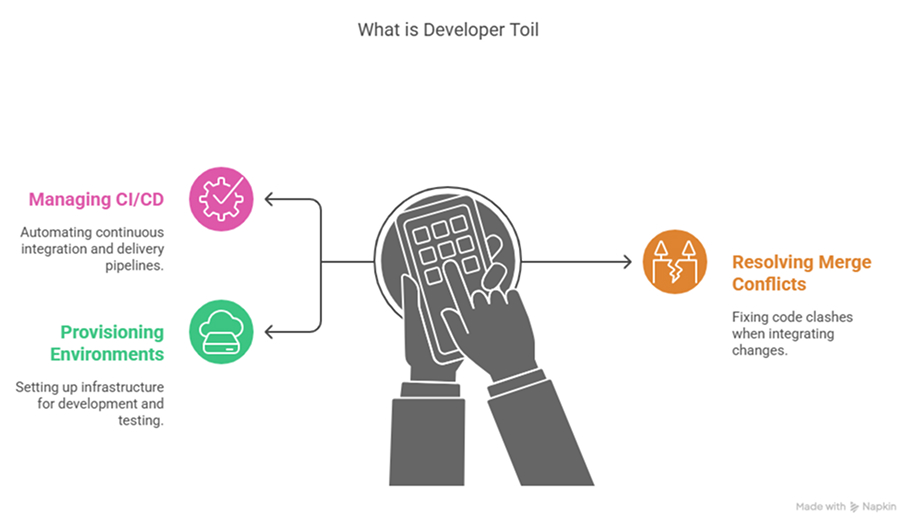Software engineers love to implement new things. However, they often find themselves burdened with repetitive and tedious tasks such as manually fixing minor issues or working around unreliable systems. This is called developer toil. It’s a problem that drains their energy, makes it hard to think of new ideas, and slows down their work, often making them feel very tired and stressed (burnout).

What is Developer Toil?
In software engineering, developer or engineering toil refers to manual, repetitive tasks that a computer could easily perform. These tasks provide little to no long-term value and tend to multiply as systems grow more complex. If not addressed, it can quietly balloon into a major productivity drain.
Toil typically has these characteristics:
- Manual and repetitive: Performed manually in the same way, over and over.
- Automatable: A computer could do it instead of requiring human effort.
- Tactical: Focused on short-term problem-fixing just to keep things going.
- No enduring value: Doesn’t improve software long-term.
- Scales with growth: More users or data will increase the toil.
Note: Fixing a critical, new outage isn’t toil. But manually restarting a service every day for a known bug? That’s pure toil.
Toil often shows up when the software mostly works but not smoothly. It needs constant small fixes to keep running. Over time, these little tasks pile up and slow developers down like a death by a thousand cuts.
Why Toil Often Goes Unnoticed
Engineering toil tends to build up quietly. Unlike major bugs or outages, toil doesn’t break systems-it just slowly consumes time and energy. Because it involves small, routine tasks, teams often accept it as part of “normal” work.
There are a few reasons why toil is easy to overlook:
- It’s not urgent: Toil rarely causes immediate failure, so it doesn’t get prioritized.
- It hides in the background: Repetitive tasks become part of daily routines and aren’t questioned.
- Teams adapt: Developers find workarounds instead of fixing root causes, which keep the system running but increase toil over time.
- Lack of visibility: Without tracking where time goes, it’s hard to measure how much toil is affecting productivity.
Recognizing toil requires intention. Teams need to regularly reflect on how they spend their time and ask whether certain tasks are really necessary or if they can be improved, automated, or eliminated.
How Toil Affects Teams and the Business
Toil affects not just individual developers but entire teams and the business. Spending too much time on repetitive manual tasks leads to frustration and lower job satisfaction. Over time, this can result in burnout or people leaving the team.
It also impacts team performance. Developers have less time to work on important tasks like building new features or improving the system. Work becomes more about maintaining the current setup instead of moving forward.
Here are some common problems caused by too much toil:
- Less innovation: Developers are too busy to build new things.
- Hard to focus: Repeated interruptions make it difficult to do deep work.
- Slower delivery: Regular tasks take longer, delaying updates.
- Lower value: The business doesn’t benefit much from manual maintenance work.
Toil often grows unnoticed. If not addressed, it can take up most of the team’s time and reduce overall engineering productivity and organizational success.
How to Address Developer Toil
Recognizing developer toil is the first step. Reducing it is an ongoing effort. Toil reduction should be a shared goal across the team, from engineers to leadership. The aim should be to identify, prioritize, and remove low-value, repetitive tasks so developers can focus on meaningful work.
Start with a Toil Audit
Begin by taking a closer look at day-to-day engineering work. A structured review can help uncover where time is being wasted. Here’s how to approach it:
- Talk to developers: Ask what tasks feel repetitive, frustrating, or like a poor use of time.
- Measure time spent: Try to estimate how much time is going into manual or low-value work.
- Connect to business value: Identify how reducing toil could improve delivery speed, reliability, or cost-efficiency.
Practical Ways to Reduce Toil
Once the main sources of toil are clear, take action with practical solutions:
- Automate where possible: Use scripts, CI/CD pipelines, or scheduled jobs to handle routine tasks.
- Simplify processes: Remove unnecessary steps in workflows or handoffs that slow things down.
- Invest in better tools: Provide reliable tools for testing, monitoring, and deployment to reduce manual work.
- Make it a team priority: Allocate time in sprints or planning cycles to reduce toil. Leadership should support this with clear goals and time allocation.
Conclusion
Reducing developer toil helps teams work faster, stay motivated, and focus on building better software. It’s a continuous effort, But it pays off in productivity, quality, and team satisfaction.
